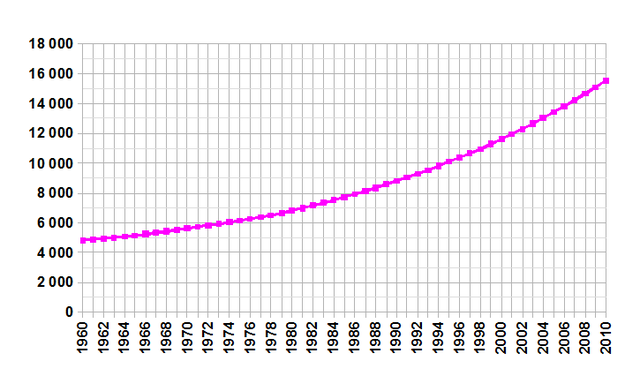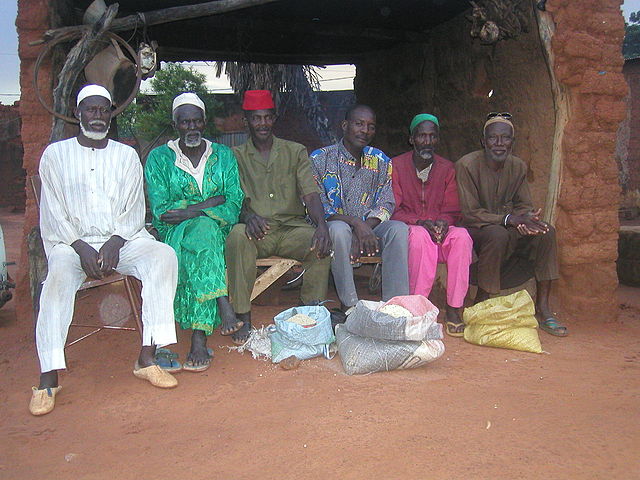Top Qs
Timeline
Chat
Perspective
Demographics of Burkina Faso
From Wikipedia, the free encyclopedia
Remove ads
Burkina Faso's 22.1 million people belong to two major West African cultural groups: the Gur (Voltaic) and the Mandé. The Voltaic are far more numerous and include the Mossi, who make up about one-half of the population. The Mossi claim descent from warriors who migrated to present-day Burkina Faso and established an empire that lasted more than 800 years. Predominantly farmers, the Mossi are still bound by the traditions of the Mogho Naba, who hold court in Ouagadougou.
This article needs additional citations for verification. (February 2013) |

Most of Burkina Faso's population is concentrated in the south and center of the country, with a population density sometimes exceeding 48 inhabitants per square kilometer (120 inhabitants per square mile). This population density, high for Africa, causes annual migrations of hundreds of thousands of Burkinabé to Ivory Coast and Ghana for seasonal agricultural work. About a third of Burkinabé adhere to traditional African religions. The introduction of Islam to Burkina Faso was initially resisted by the Mossi rulers. Christians, predominantly Roman Catholics, are largely concentrated among the urban elite.
Few Burkinabé have had formal education. Schooling is free but not compulsory, and only about 29% of Burkina's primary school-age children receive a basic education. The University of Ouagadougou, founded in 1974, was the country's first institution of higher education. The Polytechnic University of Bobo-Dioulasso in Bobo-Dioulasso was opened in 1995.

Remove ads
Population
Summarize
Perspective
Burkina Faso has a young age structure – the result of declining mortality combined with steady high fertility – and continues to experience rapid population growth, which is putting increasing pressure on the country's limited arable land. More than 65% of the population is under the age of 25, and the population is growing at 3% annually. Mortality rates, especially those of infants and children, have decreased because of improved health care, hygiene, and sanitation, but women continue to have an average of almost 6 children. Even if fertility were substantially reduced, today's large cohort entering their reproductive years would sustain high population growth for the foreseeable future. Only about a third of the population is literate and unemployment is widespread, dampening the economic prospects of Burkina Faso's large working-age population.
According to the United Nations' Population Division, the population was 20,903,000 in 2020, compared to only 4,284,000 in 1950.[2] The proportion of children below the age of 15 in 2020 was 44.4%, 53.2% of the population was between 15 and 65 years of age, while 2.4% was 65 years or older.[2]
Population Estimates by Sex and Age Group (1.VII.2021) (Data refer to national projections.):[3]
Remove ads
Vital statistics
Summarize
Perspective

Registration of vital events is not complete in Burkina Faso. The website Our World in Data prepared the following estimates based on statistics from the Population Department of the United Nations.[4]
This graph was using the legacy Graph extension, which is no longer supported. It needs to be converted to the new Chart extension. |
This graph was using the legacy Graph extension, which is no longer supported. It needs to be converted to the new Chart extension. |
This graph was using the legacy Graph extension, which is no longer supported. It needs to be converted to the new Chart extension. |
This graph was using the legacy Graph extension, which is no longer supported. It needs to be converted to the new Chart extension. |
Demographic and Health Surveys
Total Fertility Rate (TFR) (Wanted Fertility Rate) and Crude Birth Rate (CBR):[5][6] [7] [8][9]
Fertility data as of 2013 (DHS Program):[11]
Life expectancy at birth

- total population: 63.44 years
- male: 61.63 years
- female: 65.31 years (2022 est.)
- Total population: 63.06 years
- Male: 61.28 years
- Female: 64.89 years (2021 est.)
Remove ads
Ethnic groups


- Mossi 53.7%, Fulani (Peuhl) 6.8%, Gurunsi 5.9%, Bissa 5.4%, Gurma 5.2%, Bobo 3.4%, Senufo 2.2%, Bissa 1.5%, Lobi 1.5%, Tuareg/Bella 0.1%, other 12.8%, foreign 0.7% (2021 est.)[12]
Languages
- French(official), native African languages belonging to Sudanic family spoken by 90% of the population
Religion
Religion in Burkina Faso (2017-2018)[13]
- Islam (63.2%)
- Roman Catholic (24.6%)
- Protestant (6.90%)
- Animism (4.20%)
- Other and none (1.10%)
- Islam 61.5%, Roman Catholic 23.3%, Traditional/Animist 7.8%, Protestant 6.5%, Other/No Answer 0.2%, None 0.7% (2010 est.)
References
External links
Wikiwand - on
Seamless Wikipedia browsing. On steroids.
Remove ads

